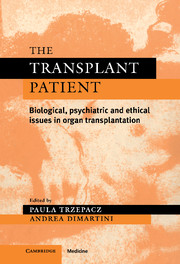Book contents
- Frontmatter
- Contents
- List of contributors
- Preface
- 1 The mystique of transplantation: biologic and psychiatric considerations
- 2 Psychosocial screening and selection of candidates for organ transplantation
- 3 Psychosocial issues in living organ donation
- 4 Quality of life in organ transplantation: effects on adult recipients and their families
- 5 Quality of life of geriatric patients following transplantation: short- and long-term outcomes
- 6 Cognitive assessment in organ transplantation
- 7 Pharmacologic issues in organ transplantation: psychopharmacology and neuropsychiatric medication side effects
- 8 Alcoholism and organ transplantation
- 9 Ethics and images in organ transplantation
- 10 Psychoneuroimmunology and organ transplantation: theory and practice
- 11 Pediatric transplantation
- 12 Current trends and new developments in transplantation
- Index
8 - Alcoholism and organ transplantation
Published online by Cambridge University Press: 14 September 2009
- Frontmatter
- Contents
- List of contributors
- Preface
- 1 The mystique of transplantation: biologic and psychiatric considerations
- 2 Psychosocial screening and selection of candidates for organ transplantation
- 3 Psychosocial issues in living organ donation
- 4 Quality of life in organ transplantation: effects on adult recipients and their families
- 5 Quality of life of geriatric patients following transplantation: short- and long-term outcomes
- 6 Cognitive assessment in organ transplantation
- 7 Pharmacologic issues in organ transplantation: psychopharmacology and neuropsychiatric medication side effects
- 8 Alcoholism and organ transplantation
- 9 Ethics and images in organ transplantation
- 10 Psychoneuroimmunology and organ transplantation: theory and practice
- 11 Pediatric transplantation
- 12 Current trends and new developments in transplantation
- Index
Summary
Epidemiology
The frequency of alcohol–related end stage organ disease is surprisingly low given the prevalence of alcoholism (nearly 9% of US adults) (Grant 1994) and the toxic effects of ethanol on the liver and heart. There is not a direct concordance between alcohol use, alcohol abuse or dependence and either the development of alcoholic cirrhosis (Simko 1983; Arria, Tarter, and Van Thiel 1991) or alcoholic cardiomyopathy (Hosenspud 1994). Evidence from the natural history of alcoholic liver disease suggests that the risk of alcoholic liver disease increases with habitual alcohol intake of 20 g ethanol/day for women and 80g ethanol/day for men (Diehl 1997) (there are approximately 10g of ethanol per standard drink). But, despite the amount of heavy drinking, the lifetime incidence of alcoholic cirrhosis only approaches 50% of people who drink excessively (i.e., consumption of 227g pure ethanol or nearly one–fifth of a gallon of hard liquor per day) for over two decades (Lelbach 1975). Inconsistencies in the risk of cirrhosis by level of alcohol consumption may be due to lack of controlling for body size, gender, and alcohol consumption patterns (frequency and temporal patterns) (Parrish, Higuchi, and Dufour 1991). Nevertheless, alcohol related end stage liver disease results typically from 10 to 20 years of heavy drinking. Though a diagnosis of alcohol-induced liver disease can be supported by medical data (liver biopsy and liver enzyme profiles) in conjunction with a history of heavy alcohol consumption, a patient may not meet the criterion for alcohol abuse or dependence in the Diagnostic and Statistical Manual of Mental Disorders, 4th edition (DSM-IV).
- Type
- Chapter
- Information
- The Transplant PatientBiological, Psychiatric and Ethical Issues in Organ Transplantation, pp. 214 - 238Publisher: Cambridge University PressPrint publication year: 2000
- 1
- Cited by



